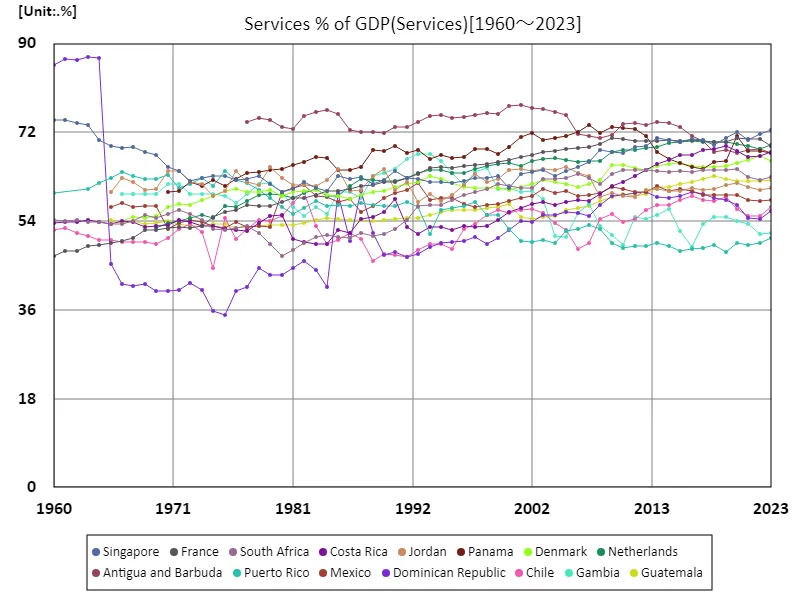Abstract
According to data for 2023, Singapore has the largest share of services to its GDP at 72.4%. This reflects Singapore’s highly developed service sectors, including finance, information and communications, and logistics, and the country’s economic focus shifting from manufacturing to services. In recent years, many developed countries have seen a decline in manufacturing and an expansion of services, particularly in the financial and technology sectors. A country like Singapore has a high proportion of the service sector due to its geographical and economic advantages as a city-state, as well as its role as an international business hub. Generally, as an economy matures, there is a shift from manufacturing to services, and knowledge-intensive industries in particular tend to grow. This can be seen as a strategic change aimed at increasing added value in the economy and maintaining competitiveness.
Service industry as a percentage of GDP
Looking at data from 1960 to 2023, the Dominican Republic recorded an extremely high 87.3% GDP ratio from agriculture, forestry and fisheries in 1963, but this has now fallen to 64.1%. This reflects, as in many countries, an economic shift away from agriculture, forestry and fishing to other industries. In the 1960s, many developing countries relied on agriculture, but as their economies have grown, the manufacturing and service sectors have expanded, and the proportion of agriculture, forestry, and fisheries to GDP has tended to decrease. In recent years in particular, the relative importance of agriculture, forestry and fisheries has declined as urbanization and industrialization progresses. However, it is also true that agriculture, forestry and fisheries still play an important role in many countries, especially developing countries, and support the foundation of life. Overall, as the economy matures, the industrial structure changes and there is a tendency for agriculture, forestry, and fisheries to account for a decreasing proportion of GDP.


The maximum is 87.3%[1963] of Dominican Republic, and the current value is about 64.1%
Service industry as a percentage of GDP (nations around the world)
Based on data from 1960 to 2023, the Dominican Republic’s service industry’s GDP ratio was very high at 87.3% in 1963, but has now fallen to 64.1%. This is because agriculture, forestry, fishing and manufacturing have come to play a larger role in the economy. In the 1960s, the Dominican Republic’s economy was primarily dependent on the service sector, but since then, as industrialization and manufacturing development progressed and the economy diversified, the service sector’s share of GDP has declined. Generally, as an economy develops, the service sector’s share of GDP tends to increase, but a decline from its peak, as in the Dominican Republic, suggests growth in the manufacturing sector and a change in the industrial structure. This reflects the interactions of various industries as the economy matures and the change in the relative importance of services overall.


The maximum is 87.3%[1963] of Dominican Republic, and the current value is about 64.1%
Service industry as a percentage of GDP (nations around the world, latest year)
According to 2023 data, The Bahamas has a very high service sector GDP ratio at 80.8%, while the global average is 54.8%. This reflects the central role that the service sector plays in the economy, as The Bahamas relies on tourism and finance. In general, developed countries and countries with developing service economies have a high proportion of GDP derived from the service industry, including sectors such as finance, insurance, tourism, and information and communications. On the other hand, in countries where manufacturing and agriculture are the main economic activities, the proportion of services tends to be relatively low. The high proportion of service industries in countries like the Bahamas reflects their characteristics as resort destinations and financial centers. The overall figure of 8.33% of total GDP is the sum of data from all countries and does not represent the characteristics of individual countries, but it does suggest the increasing international importance of the service sector.


The maximum is 80.8% of Bahamas, the average is 54.8%, and the total is 8.27k%
Services industry as a percentage of GDP (region, latest year)
According to data for 2023, agriculture, forestry and fisheries account for 65.6% of GDP in the euro area, which is a relatively high figure. Meanwhile, the overall average is 52.6%, and the total is 736%. The high percentage for the euro area indicates that agriculture, forestry and fishing remain important economic sectors, with agriculture in particular dominating economic activity. In general, in developed countries, the proportion of agriculture, forestry, and fisheries to GDP tends to decline, while the proportions of the service and manufacturing industries increase. However, the euro area has different economic structures across regions, and agriculture is relatively important in some countries, which explains the relatively high overall share. The overall figure of 736% is calculated by adding up the data from each individual country, and indicates the diversity of the international position and economic role of agriculture, forestry and fisheries. This reflects the fact that agriculture, forestry and fisheries have different impacts on different economic and social factors in different regions.


The maximum is 65.6% of Euro area, the average is 52.6%, and the total is 736%



Comments